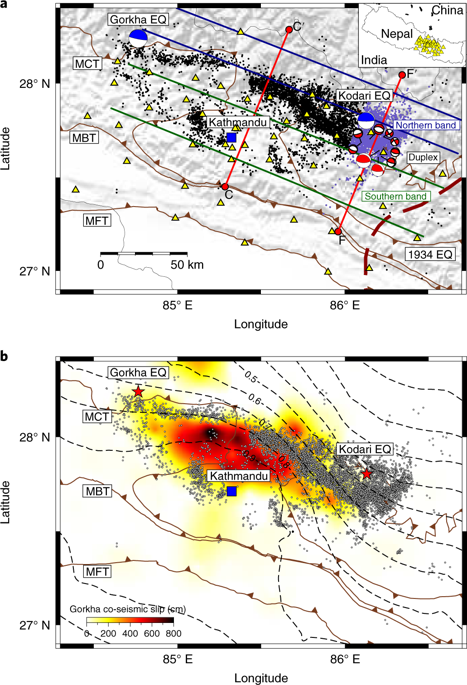Nature Geoscience ( IF 15.7 ) Pub Date : 2019-11-11 , DOI: 10.1038/s41561-019-0474-8 M. M. Mendoza , A. Ghosh , M. S. Karplus , S. L. Klemperer , S. N. Sapkota , L. B. Adhikari , A. Velasco

|
In April 2015, the lower locked portion of the Main Himalayan Thrust ruptured beneath Nepal, causing the disastrous Mw 7.8 Gorkha earthquake. Elucidating the enigmatic geometry of this plate boundary fault is important for understanding the nucleation and arrest of large earthquake ruptures as well as the seismic hazard, topography and tectonics of the Himalaya. Here we interpret the geometry of the Main Himalayan Thrust from the spatial distribution and rupture patterns of a dynamic sequence of aftershocks following the Gorkha earthquake, which were recorded by a rapidly deployed dense seismic network. We find that the thrust comprises two north-dipping subhorizontal planes that are connected by a system of bounded imbricate thrust faults; this structure is known as a duplex. We propose that this duplex acts as an impediment to plate convergence and accommodates tectonic stress along its complex system of faults. Such a prominent structure to the Main Himalayan Thrust is consistent with surface geological studies but challenges geophysically derived conventional models with simpler geometries.
中文翻译:

2015年瓦克7.8级哥尔卡地震余震照亮的喜马拉雅山主推力中的双相结构
2015年4月,喜马拉雅山主推力的下部锁定部分在尼泊尔下方破裂,造成了灾难性的M w 7.8戈尔卡地震。阐明该板块边界断层的神秘几何形状对于理解大型地震破裂的成核和阻止以及喜马拉雅山的地震危险,地形和构造具有重要意义。在这里,我们通过快速部署的密集地震网络记录的戈尔卡地震后的余震动态序列的空间分布和破裂模式来解释喜马拉雅山主推力的几何形状。我们发现,逆冲包括两个北倾的水平下平面,这些平面由有界的盘状逆冲断层系统连接。这种结构称为双工。我们提出,这种双相构造阻碍了板块的融合,并沿着其复杂的断层系统适应了构造应力。






































 京公网安备 11010802027423号
京公网安备 11010802027423号